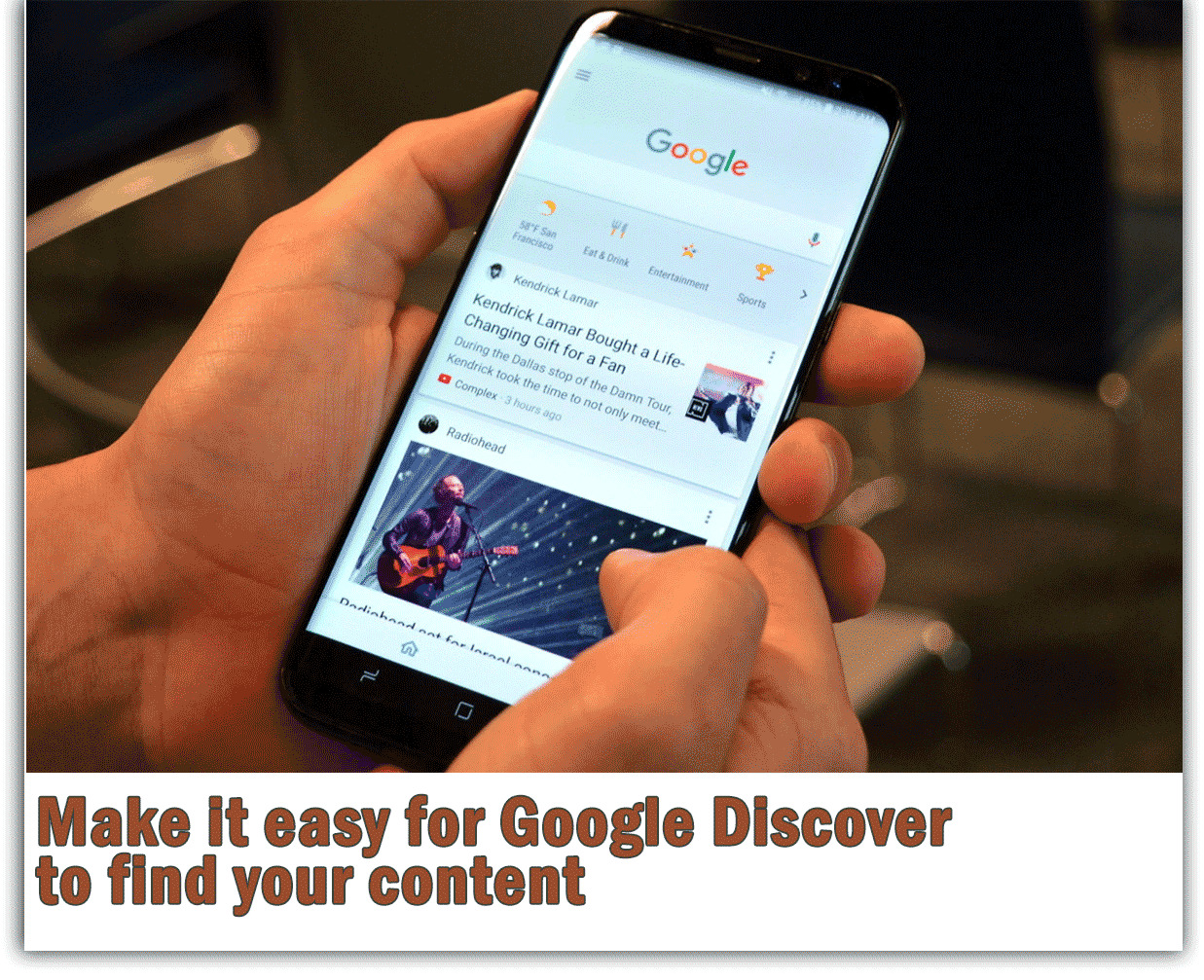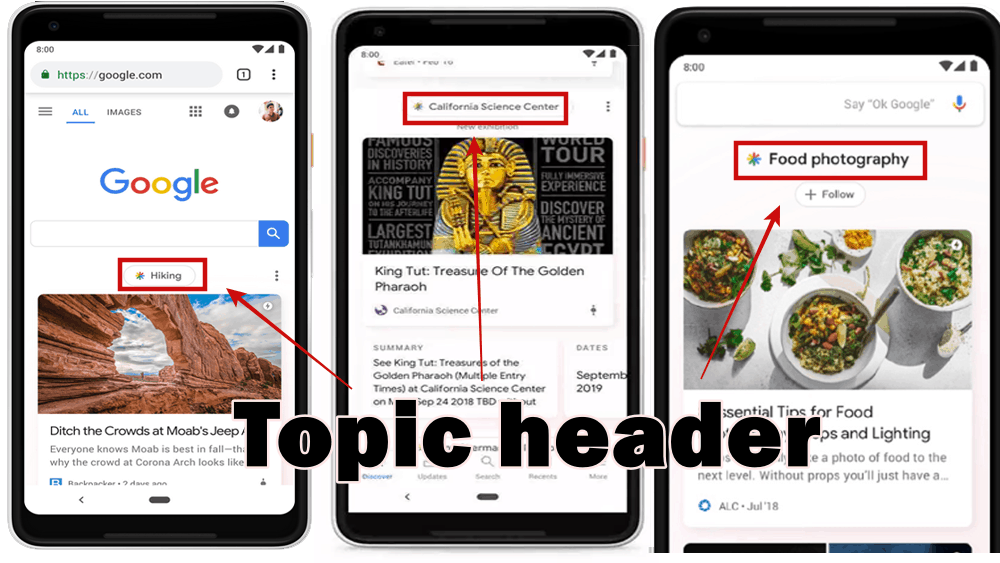Google wants you to stop searching. It wants to search high quality content for you and then fill your feed with it. If there ever was a need to create high-quality engaging content, it is now. You need to optimize your content for Google Discover.
What exactly is Google Discover and why do you need to optimize your content for it?
Google Discover is a replacement for Google Feed that you often come across when you use the Google search bar on your mobile phone, especially Google Now. Of course, there might be many Android-based phones that may not have Google Now pre-installed, but in most of the cases, your phone, or the phone of your customer or client, may be equipped with Google Now.
Since Google Discover isn’t being sent out to all the phones yet, you may still be using Google Feed. The updates on Google Feed are obtained from your search pattern and browsing history. As you know, Google tracks every activity of yours (yes, it is creepy) on the pretext that it wants to give you the content you’re looking for even when you don’t know how to find the right content.
What is the difference between any other newsfeed, for example, Facebook Stories or even Flipboard, and Google Discover?
The first difference is, Google is after all, Google, and it is present in almost every non-iOS device. Hence, its feeds are automatically there on your mobile phone and unless you are hell bent on not using them, you will end up using them. Besides, Google claims that over 800 million users are using Google Feed regularly. The moment Google Discover arrives on their mobile phones, they will automatically start using it.
The second reason is, there is nothing negative about using Google Feeds. At one single place, it gives you all the information you need to organise yourself, even your flight updates if the information exists in your email. These are called “cards” and it gives you important updates on news, sports and entertainment.
Google constantly updates your feeds according to your search history.
Then it upgraded its feeds algorithm and started anticipating what you would like to read or watch.
It no longer wanted to depend on your search pattern or browsing pattern. It now aspired to predict what you’re going to like before you even knew it. Google Discover is a highly advanced version of its older Google Feeds Avtar.
The basic point is, if people come across your content without having to search for it, they may not search for it. This also means that if they are able to find your competitor’s content, there will be no need for them to search for your content. This way, they may never search for your content.
Using artificial intelligence, Google wants you to stop searching and start discovering.
For people to be able to “discover” your content, you need to convince Google that your content is worth discovering.
People who have used Google Discover say that there have been many design changes. There is a clickable topic header above every news item or update. If you tap on that topic header, feeds specific to that topic are displayed and Google takes note of your preference. At the bottom of the card, you will be able to indicate whether you would like to see more of such updates or less.
Google Feed was previously accessible only through the Google Mobile app but now, once the Discover feed is introduced, it will be available in all Google.com mobile browsers including the “OK Google” thing.
Optimizing your content for Google Discover
Interestingly, this shift towards discovering rather than searching is in the sudden shift. Google has been modifying its content discovering capabilities for many years now and this is why a lot of stress is put on creating high-quality engaging content.
Optimizing your content for Google Discover is like sowing a tree. To eat fruit you need the tree, and there is no escaping from it, but you cannot get the fruit immediately. You will first need to plot a sampling or sow a seed. In this case, you will need to encourage your prospective customer or client to interact with your content, to engage with it, and only then Google Discover will deem it fit to keep on discovering it even when your prospective customer or client isn’t actively searching for it.
This Search Engine Land blog post has some useful tips on how to optimize your content for Google Discovery and make it more discoverable.
The first thing you need to understand while optimizing your content for Google Discovery is that it is all about the experience. What sort of experience people have with your content and how they’re going to interact with it? Are they going to be passive towards your content or they are going to share it with their friends and colleagues, share with their own timelines, link to it, spend more time going through it or even bookmark it? All these actions tell Google that people find your content valuable.
In my blog post The importance of understanding user intent in content writing, I have written about how important it is to understand what your user/searcher is looking for and whether you are providing it or not. User intent means if someone finds your content on Google, goes to your link, stays there, and then doesn’t come back to Google to carry on the exact same search, it means the searcher found on your link what he or she was looking for and now there is no need to look for the exact thing.
There is also an attribute called the Search Task Accomplishment Factor about which I have written in this Huffington Post blog post, which talks about the same thing – does the search get over one’s someone visits your link or not? If the search gets over, it means you are providing exactly what the searcher is looking for, for that exact keyword. Your rankings improve.
Factors like these are going to have a big impact when you optimize your content for Google Discovery.
The above-linked Search Engine Land blog post suggests that you take care of the following when optimizing your content for Google Discovery:
Create quality content people like to engage with
Google Discover is going to function the same way your typical Facebook Timeline functions. The updates that you see are the ones that are either similar to the updates you have interacted with before, or, are similar to updates your friends are interested in. In one way or another, it is the engagement that decides what you see on your timeline.
The same is going to happen with Google Discover.
Now, why would people interact with your content, why would they engage with it, if they don’t find your content useful, interesting, high-quality or engaging?
Proactively showcase and highlight your content
Millions of web pages, images, videos and blog posts are being published every day. People can interact with your content only if they can find it. If you are well known, they themselves look for your content. If you’re not, you will need to take measures so that they take note of your content and start interacting with it. This will entail
- Promoting your content using your social media profiles.
- Giving incentive to people to interact with your content and engage with it.
- Making your content discoverable.
- Using recommended SEO guidelines so that those who search for your content can find it.
- Using your mailing list to disseminate your content.
Use images and videos to optimize your content for Google Discover
It is already recommended that you use high quality graphics and images, on your blog posts and web pages. Google Discover will highlight important content through images and videos that are present in the same piece of content. Images and videos draw attention of people easily compared to text, this is why Google Discover is going to put more stress on your images and videos.
Publish new as well as evergreen content
Don’t rest on your laurels once you have published great content on your website or blog. You want people to keep coming back to your website for more great stuff. If you give them an indication that you have given your best and now there is nothing new to expect, they will lose interest in your website. Even Google crawlers will stop crawlingg your website or blog if your pattern becomes haphazard or rare.
Evergreen content means content people would like to bookmark, to save, to refer back to it whenever they need to recall the great information contained within that piece of content. This is also important. People would love to link to this content and when they link to this content, Google will think that this content is important and will showcase it in the Google Discover feeds.
Concluding remarks on content optimization for Google Discover
So, is active searching history? Personally, I don’t think so but I’m not a farsighted person when it comes to predicting technology and even content marketing trends. Maybe something is there that I cannot see, but, presently, I don’t think active searching is going away. This is why, every content aggregation service gives you a search bar. There is no “discovery”, “story” or “feed” service or app that does not come with a search box or a search bar. Why is it so? Because there is always a possibility of the artificial intelligence not discovering what you want.
But yes, passive browsing is here. All social networking and social media apps thrive and survive on our proclivity to browse passively. How many times do you post on Facebook or Twitter? Most of the time you are just scrolling up and down, viewing what other people have posted. These posts and updates don’t even appear chronologically. Some algorithm somewhere is deciding what you should see, and then you see it. So yes, we are already tuned to browsing passively and content being discovered for us.
Maybe, someday it will be a full circle and things will be back to the way they were on TV and radio, but more targeted and narrowed down.




